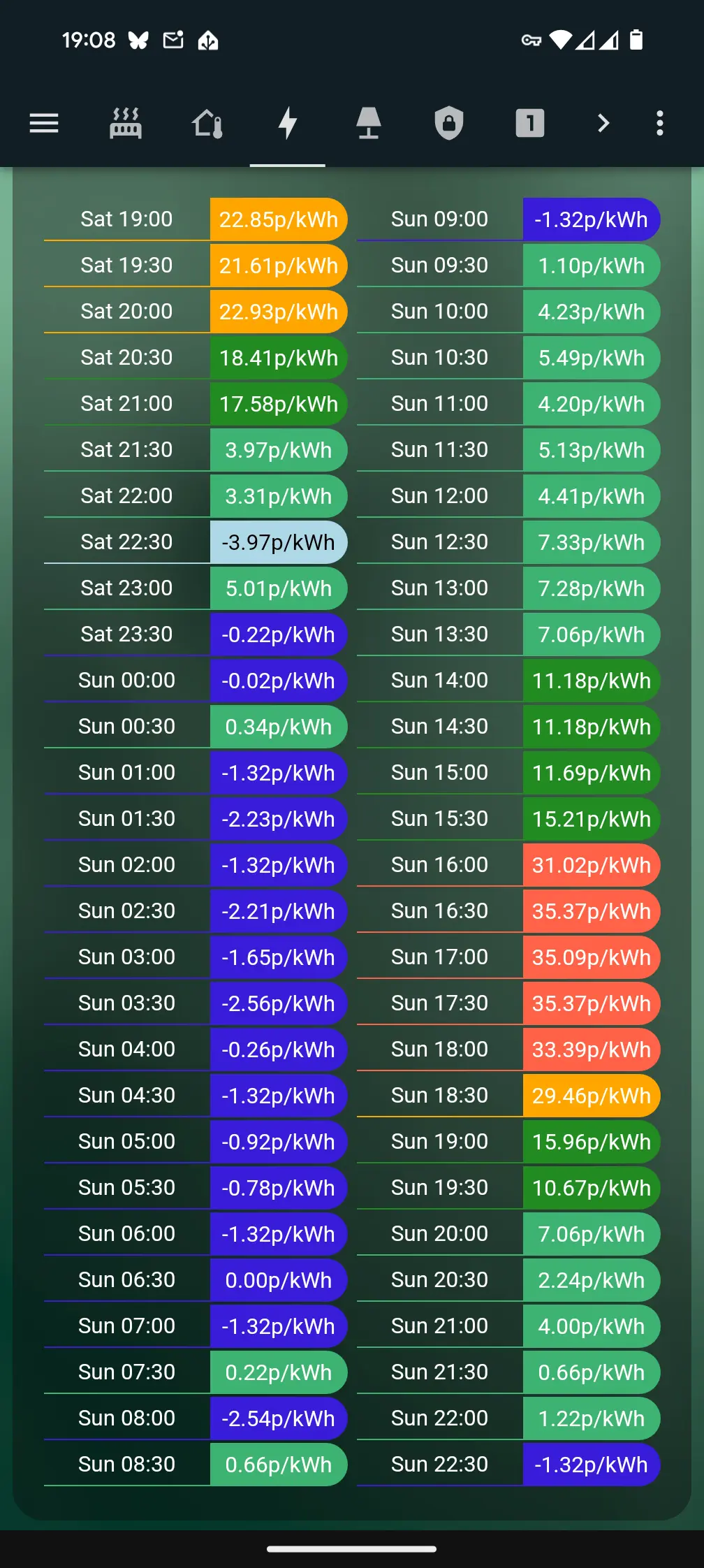this post was submitted on 23 Nov 2024
145 points (97.4% liked)
homeassistant
12251 readers
47 users here now
Home Assistant is open source home automation that puts local control and privacy first. Powered by a worldwide community of tinkerers and DIY enthusiasts. Perfect to run on a Raspberry Pi or a local server. Available for free at home-assistant.io
founded 2 years ago
MODERATORS
you are viewing a single comment's thread
view the rest of the comments
view the rest of the comments

I'll be taking advantage of the negative cost energy to charge my car. How have you got HA set up to take advantage? Is it automating certain appliances running when the rate is lowest?
Yup! No EV here, sadly, and I live in a flat but I've got storage heaters and a big hot water tank. I've got an incredibly janky template sensor that works out how many hours of heating I need for each room based on the weather forecast and an automation that activates the heaters for that many hours a day at the cheapest times. It can also turn the heating on when the price drops below a certain threshold, currently 0p.
Are there any creative energy sinks you could run when the price goes negative? I can only think of mining crypto or transcoding video or stuff like that.
Dingdingding! Correct. For the chepest two hours a day (or any time cost is negative) Home Assistant gives Portainer a kick and I sail the high seas. Whenever costs are negative I saturate my servers with BOINC CPU-heavy workloads like ClimatePrediction, Rosetta@Home, LHC@Home and World Community Grid.
Flip side of heating could be to lower the temperature of freezers. If the energy is free anyways.
In my old place I actually did this: replacing my fridge and freezer's thermostats with an ESP Home controlled relay and thermometer. This place has a fancy integrated unit that I don't want to play with too much.
One of those giaaant resistors and a significantly higher current service from the utility!!
Flip side of heating could be to lower the temperature of freezers. If the energy is free anyways.
That sounds good! I can see how that would save a lot of money on the bills. I especially like that you've got a "janky" template sensor haha. HA is so good for it's openness and letting you bodge things together which have no right to work but do so all the same!
What's your power bill look like monthly with this?
I'm currently paying £50/mo and that's with credit building up on my account. My initial investment in HA has paid for itself many time over.
My tariff comes with smart charge but I've ended up turning it off and just triggering directly with home assistant. I have two buttons: one for smart night time charge and one to enable daytime charge once the solar has heated up the hot water. However my current export rate (15p/kWh) is twice as good as the night rate (7p/kWh) so it's better to bank the export and then have a steady charge over night.
Looking at the rates the OP posted I wonder if the variable tariff would make more sense. I suspect the automation rules would be a bit more complex.
For me the car is the main thing that I can move to cheaper times. I'm also lucky in that I don't need to do that many miles so I can often wait for cheaper times to charge. If I did more miles and needed to charge more frequently/consistently then it would probably be better to have a tariff with a set night rate, sometimes there are decently long stretches where the variable tariff doesn't get as cheap as a night rate would be. On the other side there are days like this where I can get as much into the car as possible and get money back for it.
It definitely depends on your individual usage which would be better. If you're with Octopus, I believe they have a tool which will show you what you would have paid on the variable tariff over the past months, obviously that wouldn't take into account any behavioral changes you would make (or automate) if you had a variable tariff but could still be helpful.
If I had an EV it would make a huge difference. One of the really, really cool features of the Octopus integration is that you can create a binary sensor that triggers for the cheapest hours (consecutive or non-consecutive) between a set time period, so you could create an automation that works out how many hours your car needs to charge at, say, midnight, and have it only charge for the cheapest hours between then and 8am.